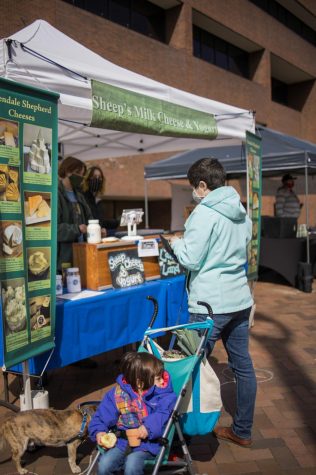For farmers and sellers in the Seattle area, March and April 2020 were nothing short of terrifying. With the beginning of the farmers market season in spring and summer, the economy suddenly had to close due to the COVID-19 pandemic. In the year since then, local businesses in Seattle have struggled to make profits and pay employees as lockdown and quarantine measures halted the traditional local farming business model, but look forward to higher demand in the months to come.
How Vaccination efforts A new normal is beginning to be established in the US, and more Seattle citizens can safely congregate. King County is beginning to ease restrictions on outdoor markets. This is good news for farmers and sellers, many of whom have had to move or have been banned from markets due to tight capacity regulations.
Sarah Schu, Marketing and Development Manager at Farmers Markets in the Seattle neighborhoodexplained how the rules affected sellers.
“What hindered us the most was the number of our suppliers. Our suppliers all had to be ten feet apart, and obviously they would be right next to each other in a typical year, ”said Schu.
These regulations resulted in sellers having to find other places to meet consumers. Another challenge was the impact of the pandemic on consumer habits. Seattle visitors last year visited farmers’ markets and local farms well below average.
“2019 was our record year, we had the highest sales in all seven markets, compared to 2020, which was gloomy at best. Then we made the tough decision not to open three of our seasonal markets. Magnolia, Phinney and Lake City last year, ”said Schu.
The lack of opportunities for vendors to connect with buyers posed a challenge for business owners who quickly had to move to other methods of selling their goods.
Dakota Begg, an employee of pasta, a specialty ravioli staple for the farmer’s market, described the rapid change in strategy required by the pandemic.
“We delivered via home delivery and that was very busy at the beginning of the pandemic. It was crazy at first and a big change, but now it’s slowing down as people start shopping again, ”said Begg.
Many farmers and sellers have adjusted to the use of services such as What is good and Full circle Offer customers contactless delivery to complement traditional farmers’ markets. Due to the closure of several stores during the height of the pandemic and lower demand for personal purchases, the services began to become popular in March 2020.
While many farmers have used online services as a temporary addition to their traditional income, the pandemic has generated significant costs. Don Wardlow, beekeeper and business owner of Golden Girls Honeydescribed the problems beekeepers are facing due to the pandemic. Since beekeepers cannot stop honey production when demand falls, they now have several thousand pounds of honey left.
Golden Girls Honey at Capitol Hill Farmer’s Market | Adeline Ong
“It’s been a great year of production with bad sales,” said Wardlow.
Golden Girls Honey produced 3,000 pounds of honey in 2017 and continues to produce several thousand pounds a year. Wardlow hopes to sell more honey this season due to the excess the company amassed during the pandemic.
“The lockdown upset the balance, now that more people are vaccinated, I hope they get back on the market,” said Wardlow.
Dale Nelson from Woodring northwest, who makes savory foods, described the impact the pandemic had on its business.
“The difficulty was keeping four people on, and I had to relieve them in March of last year. The writing was on the wall when no one showed up at Pike’s Place Market, ”Nelson said.
The difficulty of letting go of employees due to poor market conditions has been compounded by the need to reduce other companies’ fixed costs such as rent and consulting fees. Nelson paid $ 3,000 to rent a warehouse where his company had made products for several years. Closing the warehouse was a difficult but necessary cash flow decision.
“It took my brain about six months to take care of it – after 30 years of doing something, there was a sudden change. Knowing I had to do it, I just got to work and did it, but I had to throw away or give away $ 80,000 of equipment, ”Nelson said.
Nelson isn’t the only small business owner faced with painful decisions during the pandemic. A 2020 Small Business Report noted that by April 6, “mass layoffs and closings had taken place just a few weeks after the crisis began”.
This disruption of the balance between supply and demand was particularly pronounced in the Seattle farmers’ markets. Schu described the limited opportunities local sellers have faced over the past year.
“In general, we had 43% fewer market opportunities and 38% fewer market weeks than in 2019. In 2019 you could have gone to a farmers market 236 times, and in 2020 there were only 146 days on which you could have visited a market,” said Schu.
As Seattle Farmers Markets prepares to keep more locations open longer this year, Capitol Hill Market is moving to a new location this week to give vendors and community members more space to sell and shop. While vendors are thrilled with the return to farmers’ markets, they are realizing that some changes – like wearing masks and not offering samples – can remain mundane even as markets prepare for a recovery.
King County Farmer’s Market Regulations COVID-19 includes bans on public samples and more detailed hygiene measures than before the pandemic.
Bridget, a dairy worker Glendale Shepherd, described her experience during the pandemic.
“The most important skill was adaptability. We did it and a lot just kept up with the different regulations, ”said Bridget.
 Mother and daughter at the Glendal Shepherd stand at Capitol Hill Farmer’s Market | Adeline Ong
Mother and daughter at the Glendal Shepherd stand at Capitol Hill Farmer’s Market | Adeline Ong
When the pandemic hit Washington so quickly, regulations changed as policy makers learned more about COVID-19. Many farmers did not have time to wait for home orders and lift market closings before the food went bad, fearful that it would be wasted.
The Washington Department of Agriculture’s Farm to Food Pantry initiative helped farmers in the Seattle area ensure food was not wasted.
“We had a lot of money that was specifically earmarked for the Farm to Food Pantry program so we could get contracts with farmers in our systems,” said Schu.
This ensured that farmers were able to feed people who needed the most food, rather than wasting food, while still making a profit during a difficult time for local Seattle farmers.
“That was something we hadn’t done in the past few years. Exciting things happened, even though it was a very tough year for us,” said Schu.
The US Department of Agriculture also launched a food box program in 2020 as food supply chain experts see 2020 as the year of “Pandemic Pivots”That can reduce food waste. However, the national food box program encountered administrative complaints inefficiency. In order to respond quickly to additional food waste during the pandemic, the former Trump administration delegated the food box program to the U.S. Department of Agriculture, rather than the U.S. Food and Drug Administration (FDA), which usually runs federal hunger relief programs unwinds.
Washington State and King County’s systems, dealing with smaller populations and being better prepared, provided an effective source of income for farmers and ensured there was less food waste during the pandemic. How 30% of King County Residents are now vaccinated and farmers will have more opportunities to connect with buyers in the coming months.
Since Seattle farmers surround a metropolitan area, a hub for large tech companies that has done well during the pandemicNelson expects local farmers to recover faster than the national recovery.
“Most of the people who haven’t suffered have been technicians, and that’s where we live – Amazon, Google, Microsoft – all produce consumable income. I think the Seattle area will be reacting pretty quickly,” said Nelson.
In addition to a gradually improving local economy, the stimulus package recently signed by President Biden will provide an additional offer $ 10.4 billion for agriculture, including $ 5 billion Specially designed for black farmers who have faced credit discrimination and land seizure in the past. Combined with government and local support, farmers can look forward to a less difficult year than 2020 due to the more favorable policies and market climate of 2021.
The COVID-19 pandemic presented farmers with a number of challenges in 2020 and exposed the vulnerability of small businesses to dramatic changes in market conditions. In the coming summer months, local professionals and political decision-makers will embark on a complex path to economic stability.







:quality(70)/cloudfront-us-east-1.images.arcpublishing.com/cmg/BPEI2QQ76SHPPOW6X6A6WHEGX4.jpg)
















:quality(70)/cloudfront-us-east-1.images.arcpublishing.com/cmg/GLQND2AXQQO2G4O6Q7SICYRJ4A.jpg)





